B2B Lead Scoring: Guide and Best Tools for 2024
Article Updated on 12th July, 2024.
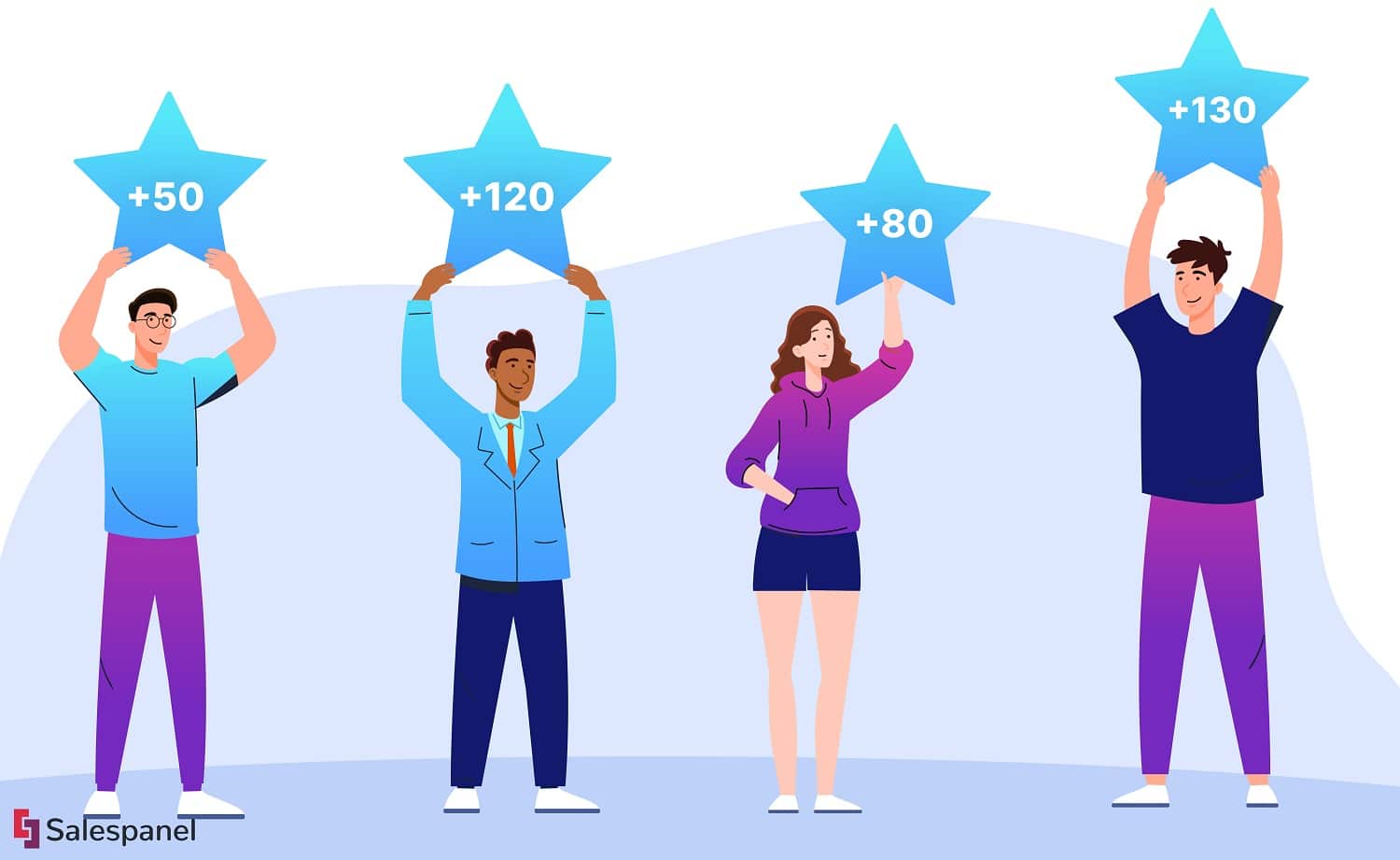
The digital landscape allows businesses to reach new audiences at a rapid pace. But, that comes at a price. Reaching more people means that you are now exposed to more unqualified leads, those that would never buy from you. And, if you are not weeding them out, you would end up wasting resources, resources that could have been spent on leads who are more likely to purchase. This is especially true in B2B where ticket prices are high and a lot of resources and time needs to be spent on acquiring those high ACV deals.
Unqualified leads don’t disguise themselves in the herd. There are obvious signals, and red flags. On the contrary, leads who are qualified also show signals, positive ones. Lead scoring is a system that turns these signals into numerical points that can help you prioritize leads.
Organizations that use B2B lead scoring experience a 77% lift in lead generation ROI, over organizations that do not currently use lead scoring. In this article, we will discuss the what, why, and how of lead scoring for B2B businesses.
What is Lead Scoring for B2B?
Lead scoring is a methodology used to rank prospects against a scale in numerical values. It uses rules to positively or negatively score leads based on characteristics and actions. Lead scoring, for B2B businesses, is done using various account and intent (first-party and/or third-party) data attributes.
Lead scoring is also used to determine the sales readiness of leads, especially in B2B sales, and move them through stages of the buying cycle. Leads can either be given positive points or negative points. Positive points are awarded for positive characteristics or behaviors (eg: lead is from a targeted business demographic). Similarly, points are deducted for negative behavior (eg: unsubscribing from important mailing subscriptions or removing payment information).
While job role and company data are key elements for initial qualification, behavioral data is what lead scoring shines with. Why? A B2B lead won’t buy on their first visit. They would gradually engage with you by consuming your content (case studies, webinars, etc.). They might also schedule a call, start a free trial, or talk to support. All of these engagement points would be used to gradually score leads.
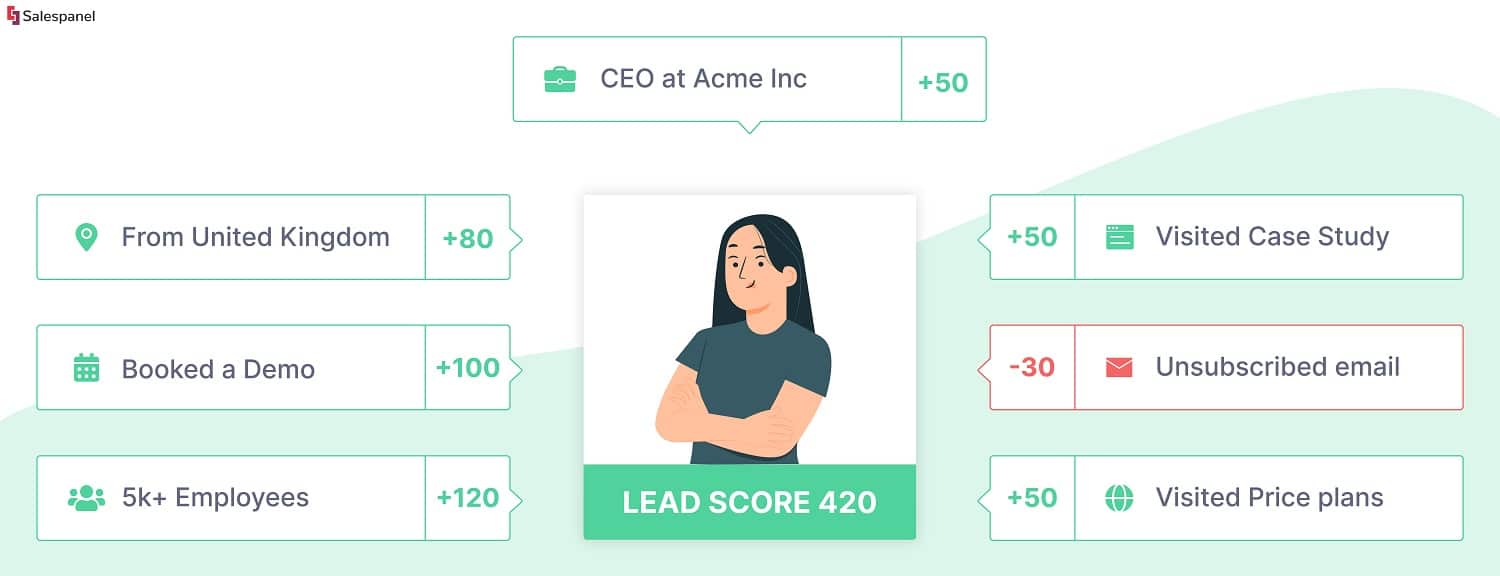
Who is Lead Scoring For? Is it the Right Thing for Your Business?
Now that we understand what B2B lead scoring is and how it works, it is time to determine if lead scoring is right for your business. Depending on how many leads you generate and your ticket size, lead scoring can either be essential or good to have. You might also not need lead scoring at all.
Lead scoring is essential for you if you:
- Process hundreds or thousands of leads per month and your sales/marketing system is being pushed to the limit.
- Have to deal with a lot of unqualified leads and waste time on them.
- Are missing out on good leads because you can’t prioritize them.
- Are you spending a significant amount of resources on leads who don’t convert?
- You want to replicate your best leads and customers and run personalized retargeting campaigns for the best leads.
If any of these apply to you, you need lead scoring. If your volume is on the higher side, both predictive and rule-based scoring will work for you (discussed later). If your volume is on the lower side, predictive scoring won’t be as effective as it relies heavily on data.
Coming to advertising, the more data you have, the more lead scoring can help you create lookalike audiences of your best leads and customers or qualify best leads and show personalized content on your website, through emails, and with retargeting.
Lead scoring is good to have for you if you:
- Have a lower volume of leads to deal with.
- You deal with unqualified leads but you don’t lose out on opportunities because of it.
- You don’t miss out on good leads because your volume is low.
- You want to replicate your best leads and customers and run personalized retargeting campaigns for the best leads.
If these apply to you, lead scoring is absolutely not essential for you but it is still something that you would benefit from having. While your reps will deal with all leads, having lead scoring will help you prioritize leads and act accordingly on leads with high scores. You can also personalize your retargeting campaigns for higher priority leads and create lookalike audiences. Your reps will also know the strong attributes of the leads (if your scoring system provides breakdowns of scores).
If you fall in this category, rule-based scoring will work more efficiently as you have less data to work with, and having close control would suit you better. Basic predictive scoring to go along with it would be a bonus.
You don’t need lead scoring at all if you:
- Are a startup or a very small business with a small number of leads generated every month.
- You have very high ticket prices (but a low volume of leads) and have a fixed selling process where you talk to all leads regardless.
If any of these match your situation, lead scoring will probably not help you much.
Why Should I Use Lead Scoring and Not Another Method?
The need for qualifying leads is pretty apparent by now. But, you might be wondering why lead scoring is the best method for B2B lead qualification. After all, you can just match with your customer profile once or have your reps qualify. The answer is simple. Lead scoring works gradually as leads progress through the funnel. In B2B, the sales cycles are longer and lead actions play a crucial factor in helping you understand their intent. Plus, if you have your reps call everyone manually, a lot of time will be wasted.
If you are still not convinced, here’s data for you, going into 2024:
- According to Hubspot, the top priority for the next 12 months for most marketers (40%) is to generate more leads.
- According to Semrush, generating more quality leads is a priority goal for 79% of marketers worldwide.
- 34% of people interviewed by Pipedrive claimed that lead qualification and prospecting are the biggest challenges for salespeople.
Breakdown of Data Points
Let’s have a look at all the sales and marketing data points that can be used to qualify leads:
Individual Data: This data consists of information about the person who is evaluating the product on behalf of their company. The most commonly used individual data for lead qualification are job role and seniority. This helps in identifying leads who are decision-makers.
Company Data: This dataset consists of firmographic information of your leads like company size, industry, revenue, etc. The data helps you filter out leads who match your target business profile and also separate leads based on ticket size.
Attribution Data: This data point connects your qualification strategy with your marketing campaigns. Let’s take an example. You are a CRM company and you are running an ad campaign on keyword ‘CRM’. Two leads land from this campaign with one landing after searching ‘best CRM software’ and the other after searching ‘what is a CRM’. Which of them do you think has higher buying intent? Similarly, leads who visit after finding your blog post from social media usually have lower intent/urgency than those who visit your website while actively looking for your product.
Marketing attribution connects your leads to campaigns and source of visit which in turn helps you qualify your leads. The loop gets closed in the sense that marketing attribution helps you identify campaigns that bring you the most customers which you, in turn, use to prioritize leads and amplify the outcomes of higher-performing campaigns. So, leads from historically better-converting campaigns can be given higher scores.
Behavioral Data: As we mentioned earlier, this is the data point where gradual scoring comes into action. Leads perform different activities while interacting with your content and touchpoints. As leads perform these desired or undesired activities, their score keeps changing dynamically. Apart from helping understand a lead’s intent for initial qualification, behavioral data also helps in moving leads through different stages of the buying process and serving personalized content.
Sales/CRM Data: This dataset brings information from sales to marketing for revenue attribution, lead qualification and targeted nurturing. The information from sales interactions and CRM databases can be brought back to marketing for an aligned qualification effort.
Businesses also use other data points like technographic data and demographic data in accordance to their requirements. Lead scoring is heavily reliant on data and data enrichment is needed for a proper lead scoring strategy.
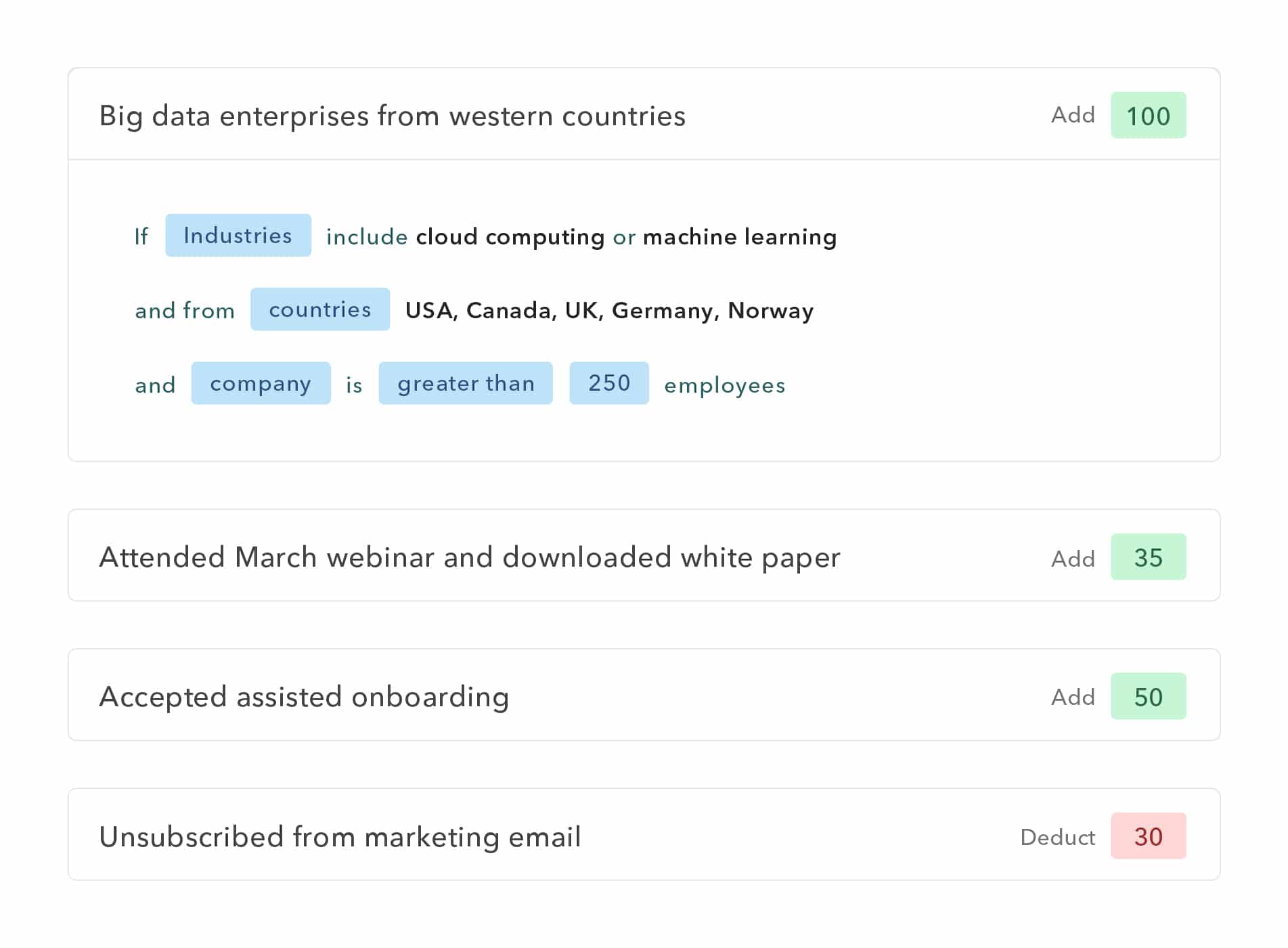
Types of Lead Scoring
There are two prominent methods to score leads: predictive and rule-based. Let’s have a look at them and find out how they differ from each other.
Predictive Lead Scoring:
A predictive lead scoring software uses algorithms to automatically score your leads based on your marketing or sales data. Some lead scoring software would also use external data or combine with a third-party data enrichment software to score your leads.
Predictive lead scoring is completely automatic and will work based on the data it is fed and how the software has been designed.
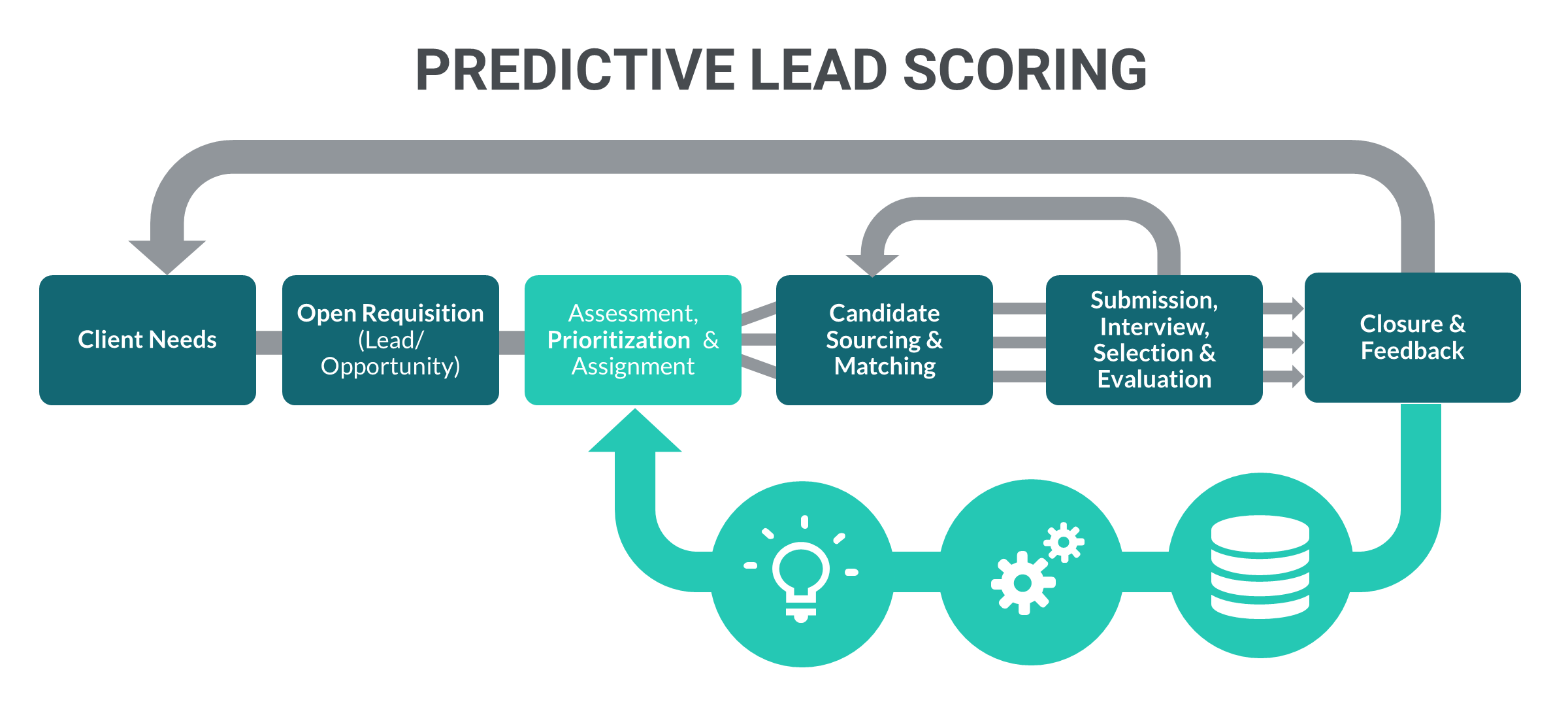
Source: https://untitled-research.com/blog/lead-prioritization-with-predictive-analytics-in-recruitment
Rule-based Lead Scoring
Rule-based lead scoring is a simpler lead scoring method where you set up rules to score your leads. Rules can be set up based on the data available to you and the functionality provided by the lead scoring software.
When a lead triggers a rule set by you, the lead score is updated. You can set up rules based on desired or undesired characteristics and behaviors like we mentioned before and the score will keep changing. You can then trigger workflows based on lead score or set up a minimum scoring threshold to mark a lead qualified. For example, you can create a system where when a lead accumulates a minimum score of 100, they are sent to sales or served pre-sales content.
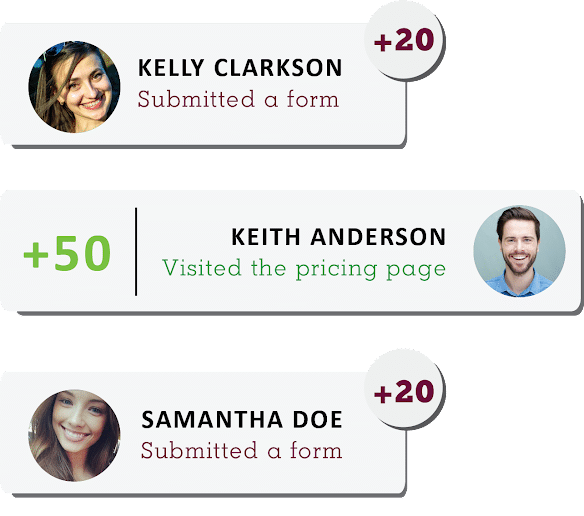
The Key Difference Between Predictive Lead Scoring And Rule-based Lead Scoring Approach
The main difference in these two approaches is that with predictive lead scoring, the software does the work for you and with manual lead scoring, you set up your lead scoring workflow based on how you intend it to work. Rule-based lead scoring offers you the flexibility to set up your rules how you want to and assign weightage to each characteristic or behavior.
Let’s say, based on previous won deals, you have found out that a key product interaction (eg: trial extension) is a very strong indicator of purchase intent. You can simply create a lead scoring rule for this but can a predictive lead scoring software find this correlation? Maybe it can, but this entirely depends on how the machine learning process and the algorithm works. So, the results might vary from software to software. Also, it would be harder to use predictive lead scoring to move deals across different stages of the buying process through stage-based nurturing.
The advantage predictive lead scoring has over rule-based lead scoring is that it can pull data from a lot of different sources and you essentially don’t have to work on setting anything up yourself or analyze data to find key indicators. Depending on which software you use, you might also need to subscribe to data vendors for setup. This applies to both predictive and rule-based solutions but not all vendors need you to purchase 3rd-party data. Salespanel, for example, comes with data out of the box.
8 Best B2B Lead Scoring Tools in the Market for 2024 and Their Prices
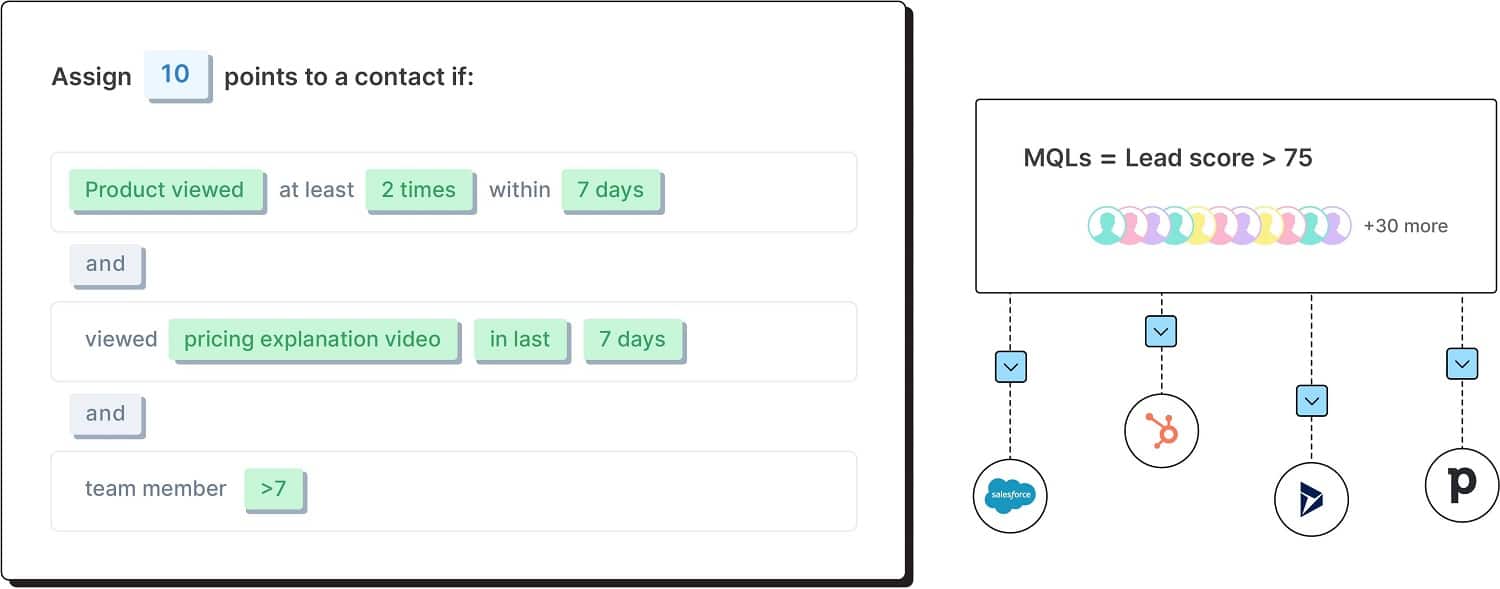
In this section, we will cover some of the top B2B lead scoring tools available in the market and compare their features and prices (for the ones that have open pricing, of course!). We will also explain how each tool helps you score leads.
This is not a ranked list, by the way. You be the judge!
Salespanel
We spent a lot of blood and sweat on this article, creating it and updating it constantly. Only fair if we start this list with our tool, eh? Maximum impressions that way! 😀
Sales pitch in 3…2…1…
Salespanel helps you automatically capture your leads from different acquisition channels and track their touchpoints and score them in real-time. So, not only do you use lead data but also use buyer intent data to score as they gradually engage with your marketing content. When it comes to buyer intent data, Salespanel’s tracking goes in-depth. From tracking how a lead originated to tracking specific actions like button clicks, video views, or pageview duration, Salespanel can do it all. Your team can also set up custom action events. For example, if you are a SaaS product, and leads who watch the onboarding video or download a specific case study are more likely to convert, you can track those specific events to score your leads.
Salespanel primarily provides you rule-based lead scoring which helps you set up your own rules and score your leads. But, we also provide you a predictive scoring system out of the box that uses AI and machine learning to score not only your leads and accounts but every visitor on your website. You can take proactive actions by qualifying your visitors in real-time and personalizing the content accordingly. How neat is that?
Lead scoring is available on $249/m and higher plans. Talk to us to learn more. Salespanel plans scale as you scale and is suitable for all types of B2B businesses that have at least 1000 visitors on their website.
Hubspot Lead Scoring
Hubspot is the “#1 CRM” in the world (according to their website). And, for those who are familiar, it does absolutely everything. So, Hubspot providing a lead scoring tool among all other things is not a surprise. It provides predictive lead scoring in both Marketing and Sales Hub plans and rule-based lead scoring in only their Marketing Hub plan. Rule-based lead scoring in Hubspot helps you score your leads using lead profile, firmographic, and behavioral data points. Coming to the pricing, Rule-based scoring is available on Marketing Hub Professional (starting at $890/m) and Marketing Hub Enterprise (starting at $3200/m) and predictive scoring is available in both Marketing Hub Enterprise (starting at $3200/m) and Sales Hub Enterprise (starting at $1,200/m) plans.
Who is this ideal for? This is ideal for an Enterprise that is already using Hubspot’s products like the CRM or Marketing Hub and doesn’t have any budgetary restrictions. While predictive scoring comes at industry standard pricing, we think rule-based scoring is on the expensive side of things!
Infer
Infer (now part of IgniteTech) is a predictive lead scoring solution that uses AI and machine learning to score your leads and accounts. Ignite is big on predictive modeling and is usually suitable for Enterprise clients with a huge customer database at their disposal. So, if you have a high volume funnel and an established sales team, Infer can help you predictively use existing data to score leads and help your sales reps prioritize leads who are more likely to buy. If you are in the market for a predictive lead scoring tool, this is definitely one of the best options along with Madkudu (we get to that in a bit!).
Coming to the pricing, Infer has not disclosed the price. And, ever since it has come under the IgniteTech banner, the information available on it has become fairly limited. If you are interested, it is best to contact them directly. But, considering the fact that this product has been designed for large Enterprises, we expect the pricing to be on the higher end.
ActiveCampaign
With ActiveCampaign, we come back to simple lead scoring. Originally an email marketing tool, it is now a “Customer Experience Automation Platform” that still heavily focuses on email marketing. ActiveCampaigns provides you rule-based lead scoring based on website and email marketing activities.
Coming to pricing, ActiveCampaign provides lead scoring starting at $49/month and it is surely one of the cheapest lead scoring tools in the market. So, how does it differ from fellow lead scoring tools that cost higher? As we mentioned earlier, ActiveCampaign is primarily an email marketing focused software and as such, their lead scoring feature also revolves around email engagement and basic website visitor tracking (unlike Salespanel which goes deep into first-party data or Infer that specializes in predictive scoring). However, with such a great entry point, this is perfect for small businesses who want to get their hands on lead scoring and also have a need of an email marketing software.
Madkudu
Madkudu is another predictive lead scoring software and can be considered a direct rival of Infer on this article. Specializing in Product-led growth, Madkudu takes in data from different marketing tools in your stack and uses predictive modelling to help you find product qualified leads and prioritize them. The Pro here is that for companies that struggle to identify intent customer touchpoints, this product does the heavy lifting. And, the software is really good at it. The Con here, like any other predictive scoring tool, is that you have less control.
With pricing starting at $1999/m, Madkudu is a best-in-class predictive scoring product for mid-market product companies that are looking to automatically find out product qualified leads from a large list of trial and freemium users.
Breadcrumbs is a lead scoring tool that works by hooking itself to your techstack and using machine learning assisted scoring model to score your ‘contacts’. The interesting part here is that while its machine learning assisted à la predictive, you can create your own models to score leads keeping your requirements in mind.
The price for the product starts at $999/month and will help you score 2000 contacts. Since integration is a major part of the product, we have to mention that it works with Intercom, Hubspot, ActiveCampaign (See? No competition here!), Mailchimp, Marketo, Mixpanel, Pendo, Salesforce, and Segment.
These are the products we would recommend you to check out depending on your budget and requirements. If you find Salespanel interesting, please sign up or reach out to us. We would love to speak with you!
Setting Up Lead Scoring
For predictive lead scoring, setup is fairly simple. Integrate the software with your CRM, marketing tools, data enrichment service, or your website, and you are good to go. The software will start scoring your leads automatically. For rule-based lead scoring tools, in addition to connecting your lead scoring software to your sales and marketing workspace, you need to set up your rules. The flexibility of rule-based lead scoring requires a bit more effort in setting up your workflow.
In this article, we are covering the lead scoring setup with Salespanel. The fundamentals, however, should be similar for other tools as well. With Salespanel, you receive individual, company, and activity data right from the start. You need to connect Salespanel to your website and your CRM if you want to use sales data. Once set up, you can create various rules based on the data provided.
Before setting up your rules, research your previous deals to identify strong indicators. Useful data filters include job role, company size, page visits, email engagement, etc. Behavioral data allows you to progressively score leads and move them through the sales process. If you need more information to identify strong indicators, check out reports on Salespanel and discuss with your sales team—they often know which indicators are stronger.
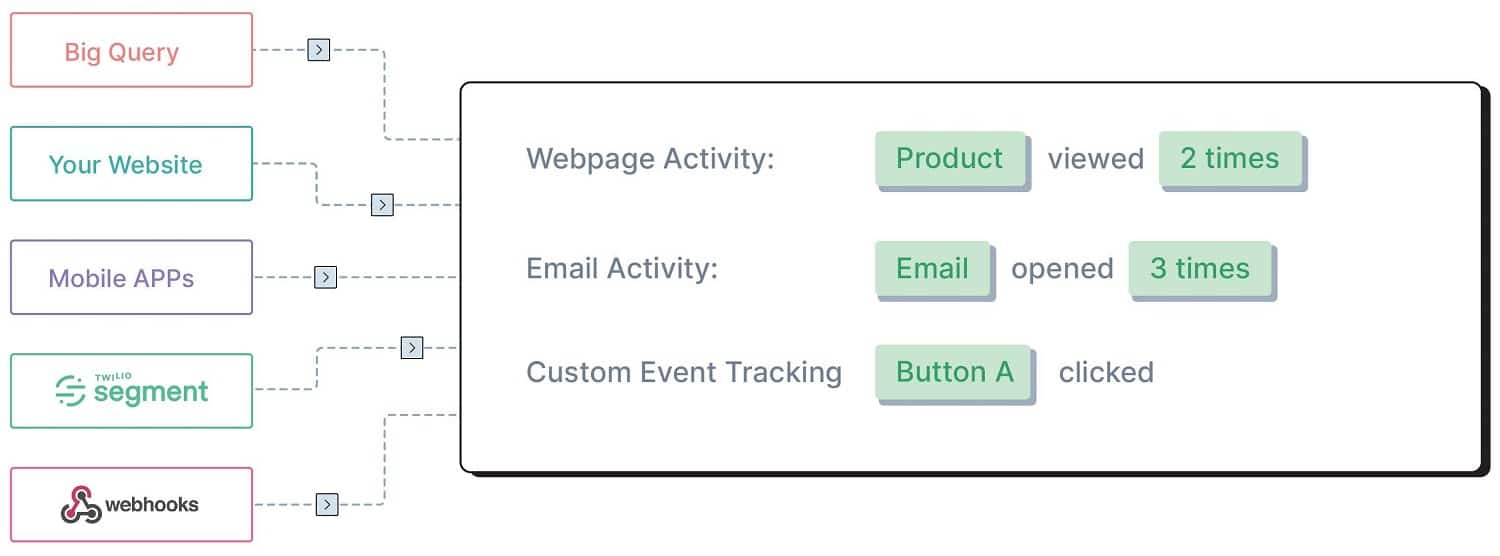
Examples of B2B Lead Scoring Models to Help You Get Started
To help you get started with lead scoring, we will share examples of two lead scoring models. The first uses account data to score leads and match them to your customer profile and the second uses behavioral data to gauge buying intent. You can also mix and match from both of these models to create your own model. These models can be created with lead scoring tools like Salespanel.
Example 1: Account-Based Lead Scoring Model
This model uses account information such as employee count and revenue to score leads. Leads from accounts that align closely with the company’s target customer profile are scored higher.
Scoring Components:
1. Demographics:
- Employee Count:
– 1-50 employees: 10 points
– 51-200 employees: 20 points
– 201-500 employees: 30 points
– 501-1000 employees: 40 points
– 1001+ employees: 50 points - Annual Revenue:
– <$1 million: 10 points
– $1-10 million: 20 points
– $10-50 million: 30 points
– $50-100 million: 40 points
– $100+ million: 50 points
2. Industry Fit:
- High-fit industries (e.g., Tech, Finance): 30 points
- Medium-fit industries (e.g., Healthcare, Education): 20 points
- Low-fit industries (e.g., Retail, Hospitality): 10 points
3. Geographic Location:
- Preferred regions (e.g., North America, Europe): 20 points
- Secondary regions (e.g., Asia, South America): 10 points
- Other regions: 5 points
4. Company Growth Rate:
- High growth (20%+ annual growth): 30 points
- Moderate growth (10-20% annual growth): 20 points
- Low growth (<10% annual growth): 10 points
Process:
- Identify the enrichment attributes you would need to create your model.
- Confirm if the data is available on your lead scoring tool.
- Create your rules and complete setting up your module.
- Test if your module is working as intended.
For example, a lead from a tech company with 300 employees, $25 million in revenue, located in North America, and experiencing high growth would score: 30 + 30 + 30 + 20 + 30 = 140 points.
Example 2: Behavior-Based Lead Scoring Model
This model scores leads based on behavioral data such as time spent on specific converting pages and buyer intent showing pages like Pricing and Case Studies.
Scoring Components:
1. Behavior:
- Time Spent on Website:
– <1 minute: 5 points
– 1-3 minutes: 10 points
– 3-5 minutes: 20 points
– 5+ minutes: 30 points - Page Visits:
– Product Page: 20 points
– Pricing Page: 30 points
– Case Studies Page: 25 points
– Blog or Resources Page: 10 points - Downloads:
– Whitepapers or E-books: 30 points
– Product Brochures: 20 points - Forms Filled:
– Contact Form: 25 points
– Demo Request Form: 35 points
– Newsletter Signup: 10 points - Email Engagement:
– Opens: 5 points per open
– Clicks: 10 points per click
Process:
- Identify the behavioral attributes you would need to create your model.
- Confirm if the attribute is available on your lead scoring tool.
- Create your rules and complete setting up your module.
- Test if your module is working as intended.
For instance, a lead who spent 4 minutes on the website, visited the Pricing and Case Studies pages, downloaded a whitepaper, filled out a demo request form, and attended a webinar would score: 20 + 30 + 25 + 30 + 35 + 20 = 160 points.
Syncing Data and Triggering Marketing Automation
The lead scoring data can stay on your lead scoring software but it makes more sense if you leverage the data to trigger certain workflows or send the data to sales to help them prioritize hot leads. Salespanel can sync lead scores to other platforms like your CRM or Slack instantly. This will help your sales know about intent signals in real-time and prioritize hotter prospects. You can also create a system to notify sales when leads cross a certain minimum score.
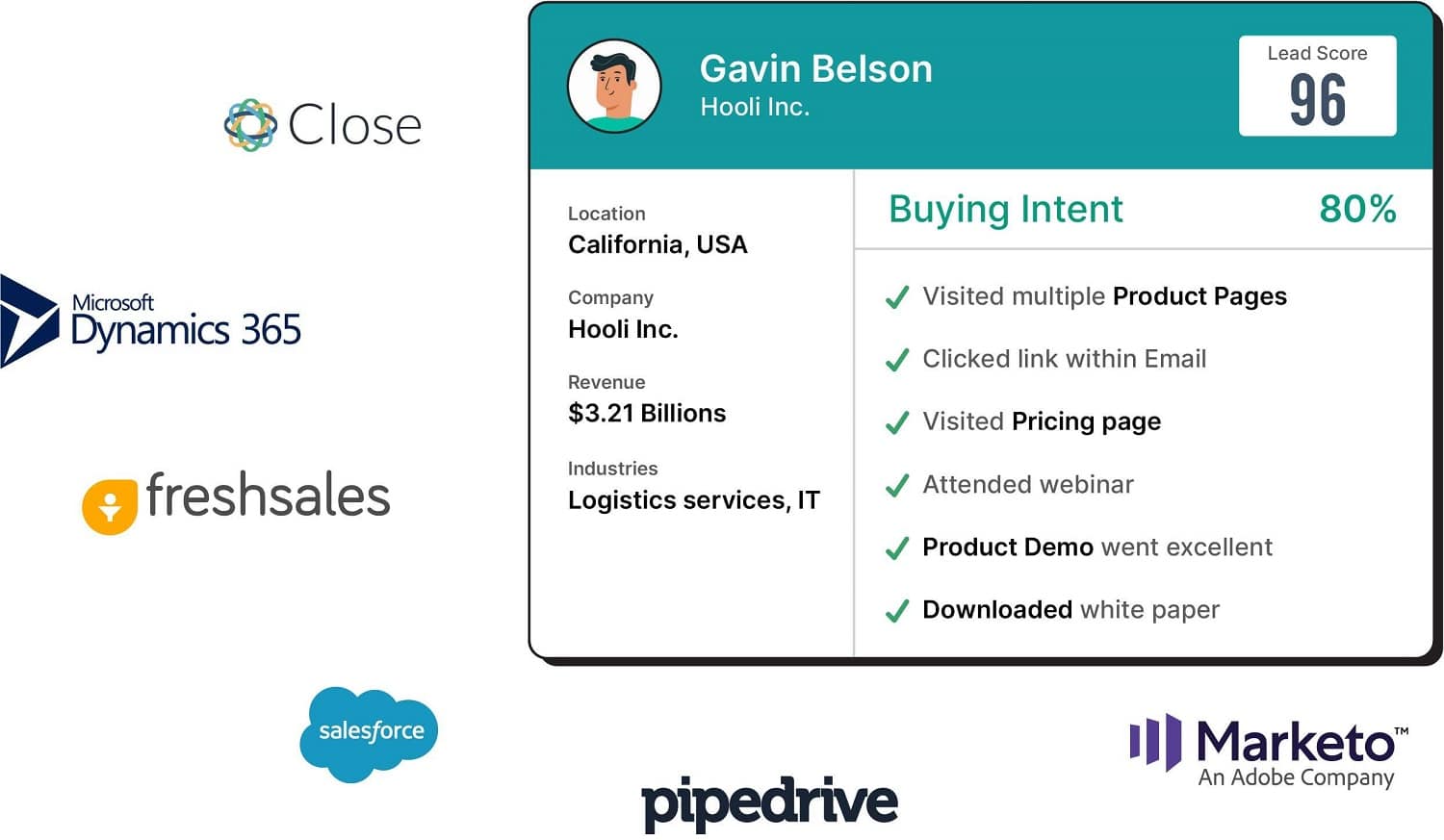
Lead score can also be used to trigger nurturing campaigns or optimize bidding value for your retargeting and nurturing campaigns. We will talk more about it in the future. Please leave us a message if you are interested in knowing more.
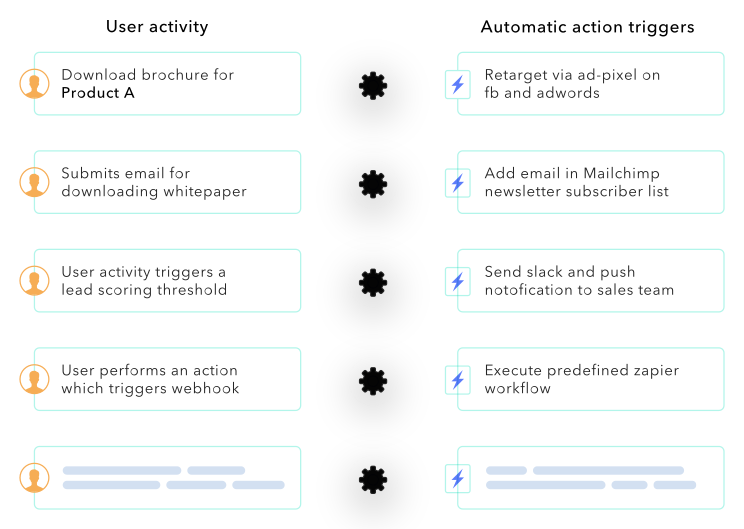
To conclude, lead scoring is a crucial asset in modern B2B sales and marketing. It can be beneficial for all digital businesses irrespective of size. While predictive lead scoring is more geared towards enterprise businesses with high volume, rule-based lead scoring can be helpful for all.
Sell more, understand your customers’ journey for free!
Sales and Marketing teams spend millions of dollars to bring visitors to your website. But do you track your customer’s journey? Do you know who buys and why?
Around 8% of your website traffic will sign up on your lead forms. What happens to the other 92% of your traffic? Can you identify your visiting accounts? Can you engage and retarget your qualified visitors even if they are not identified?


